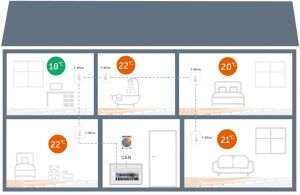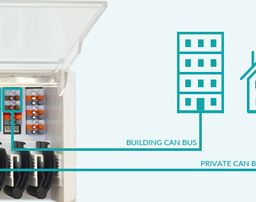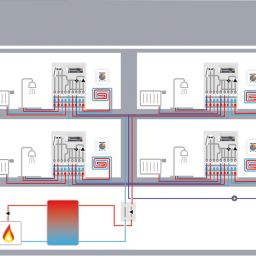Installing a multi-zone control of surface heating systems with only 1 thermostat
Reading time: 4 Min
Figure 1: Application example with 1x °CALEONbox, 1x °CALEON Controller, and 5 digital 1-Wire sensors for multi-zone control of an underfloor heating system
Multi-zone control provides the right heat quantity room by room on demand. In addition to increasing comfort, multi-zone control can also reduce energy consumption. In countries like Germany, for example, it is even mandatory in the current energy saving regulations.
The standard: Each heating zone with its own thermostat
With surface heating systems, multi-zone control is normally achieved by installing a separate thermostat in each room. These are often simple bimetallic thermostats, where the set temperature can only be influenced by a visual judgment using a rotary wheel. In addition, the user does not receive any information about the actual temperature.
A meta-study by the RWTH Aachen University, on the other hand, suggests that more information alone can nudge the consumer towards more energy-efficient heating behaviour of up to 12%. In principle, the same should apply to the visibility of the current temperature. According to the motto: the best surface heating system can ultimately only be as smart as its operator. Such a system is therefore inexpensive to purchase, but only offers the basic functionality. Over the years, the operator and the environment could incur some hidden costs in addition to the rather low level of comfort.
Another way is to install a thermostat with display in each room. Here the actual temperature can be read out in each room, an energy saving mode can be activated or a time program can be set. For wealthy customers or in commercial applications this may be the optimal solution. With high-quality thermostats, however, the system costs quickly rise to heights that exceed the budget of some applications. In addition, there is no possibility to access all rooms from one place. For example, to avoid having to walk from room to room to reduce the temperature before a weekend trip.
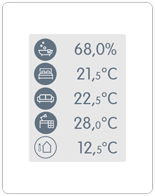
Figure 2: Controlling all rooms from one thermostat via multi-room feature
Using Multi-Room Function to Control Every Room separately with only 1 Thermostat
The °CALEONbox control system is designed for multi-zoning of surface heating and cooling applications. It is also possible to install a separate thermostat in each room, but this is only one of many options.
Suitable room sensors can also be installed, which transmit their measured values via digital 1-wire bus to the °CALEON Controller, which acts as the central control panel for the entire control system. Here, the system is parameterized via TFT display, the actual values of all rooms are read out and the setpoint values for each room are set individually. This keeps the system costs manageable and provides both installers and consumers with convenient operation.
Multi-Room in Commercial Applications
For commercial installations such as hotels or offices, centralized room management is particularly useful for keeping track of all rooms in the building. This could be achieved using a smartphone app, provided that it has access to all rooms. The °CALEON app, for example, provides this.
In some commercial constellations, however, the use of an app is not sufficient or simply impractical. An app may be ideal for the boss, but a janitor, for example, may not even have a suitable business cell phone. In this case, the multi-room feature, i.e. the possibility of accessing all rooms via a central thermostat, would be particularly practical.
Modular product design makes an infinity of combinations possible
The mentioned applications “1 thermostat per room” and “1 thermostat for all rooms” are only the endpoints of a spectrum. There may just as well be applications in which some rooms are to be equipped with and others without control panels. For example, to make at least 1 control panel available on each floor, to allow the visitor in a guest room to influence his room temperature, or not to allow this in children’s rooms. Since °CALEON controllers and room sensors can be combined with each other as desired, all constellations are possible.
The room sensors themselves are also available in many variants and are fully modular:
- Surface-mounted or flush-mounted for integration in common switch product lines by Gira, Merten or Jung
- Wired or with wireless data transmission via WiFi
- Temperature measurement only, or temperature + relative humidity for dew point calculation in cooling mode
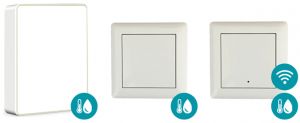
Figure 3: Matching room sensors with 1-wire bus: on-wall, in-wall and in-wall with WiFi transmission
The Right Configuration for any Application
The HVAC industry is quite retrofit-driven, heating systems and customer requirements are very diverse. We have therefore designed our multi-zone controls to be able to adapt to the local conditions on site in the best possible way – whether with one, two, or many thermostats in a given system is decided by the customer. To find the right configuration for a specific application, take a look at the °CALEONbox configurator.





